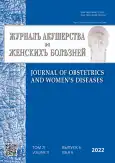Epithelial-mesenchymal transition as a pathogenetic mechanism of development and progression of adenomyosis
- 作者: Pechenikova V.A.1, Gaidarova A.A.1, Churkin K.S.1, Pertovskaia N.N.1
-
隶属关系:
- North-Western State Medical University named after I.I. Mechnikov
- 期: 卷 71, 编号 6 (2022)
- 页面: 29-38
- 栏目: Original study articles
- URL: https://journal-vniispk.ru/jowd/article/view/125988
- DOI: https://doi.org/10.17816/JOWD108828
- ID: 125988
如何引用文章
详细
BACKGROUND: In recent years, an important role in the pathogenesis of adenomyosis has been assigned to invasive properties of the cells of the basal layer of the endometrium, which provide them with the capacity to grow into the underlying layers of the myometrium.
AIM: The aim of this study was to evaluate the invasive and migratory properties of the ectopic and heterotopic endometrium in patients with adenomyosis.
MATERIALS AND METHODS: We performed clinical, morphological and immunohistochemical analyses of the surgical material of 98 patients with adenomyosis. Immunohistochemical study was carried out according to the standard avidin-biotin method, using mouse monoclonal antibodies to estrogen receptors, matrix metalloproteinase type 9, vimentin, and fibronectin (DAKO, Denmark) as primary immune sera.
RESULTS: The maximum number of estrogen receptors in both the proliferation and secretion phases was found in the endometrial glands and superficially located endometrioid heterotopias. A weaker expression of this marker was also found in the cells of the cytogenic stroma. In the foci of adenomyosis, located in the deep layers of the myometrium, the expression of estrogen receptors in the epithelial and stromal components of heterotopias varied in a wide range from 0 to 100%. The most pronounced expression of matrix metalloproteinase type 9 was characteristic of the epithelial component of superficial endometrioid heterotopias. In the foci of adenomyosis, located in the deep parts of the myometrium, a pronounced expression of matrix metalloproteinase type 9 was preserved in the proliferation phase, and its significant decrease was found in the secretion phase. The glands of the eutopic endometrium were also characterized by a more significant level of matrix metalloproteinase type 9 expression in the proliferation phase in comparison with the secretion phase. A pronounced expression of vimentin was detected in the epithelium of the glands of both superficial and deep foci of adenomyosis, as well as in the eutopic endometrium (100%). In the cytogenic stroma, the largest area of vimentin expression was found in the eutopic endometrium and superficially located endometrioid heterotopias. However, its value significantly decreased in the foci of adenomyosis located in the deep parts of the myometrium. The largest area of fibronectin expression was characteristic of the cytogenic stroma of superficial adenomyosis foci.
CONCLUSIONS: The displacement of elements of the eutopic endometrium into the thickness of the myometrium and further progression of adenomyosis is provided by two parallel pathogenetic mechanisms, namely, invasive growth due to matrix metalloproteinase type 9 activation and epithelial cell migration due to the epithelial-mesenchymal transition.
作者简介
Victoria Pechenikova
North-Western State Medical University named after I.I. Mechnikov
编辑信件的主要联系方式.
Email: p-vikka@mail.ru
ORCID iD: 0000-0001-5322-708X
SPIN 代码: 9603-5645
Researcher ID: ААВ-2105-2021
MD, Dr. Sci. (Med.), Professor
俄罗斯联邦, Saint PetersburgAnna Gaidarova
North-Western State Medical University named after I.I. Mechnikov
Email: a.gaidarova@yandex.ru
ORCID iD: 0000-0003-2391-502X
俄罗斯联邦, Saint Petersburg
Konstantin Churkin
North-Western State Medical University named after I.I. Mechnikov
Email: osia_911@mail.ru
ORCID iD: 0000-0001-6647-8531
俄罗斯联邦, Saint Petersburg
Nikol Pertovskaia
North-Western State Medical University named after I.I. Mechnikov
Email: dr.ramzaeva@mail.ru
ORCID iD: 0000-0001-6849-5335
SPIN 代码: 7769-1969
Scopus 作者 ID: 57838172500
Researcher ID: GLR-8455-2022
俄罗斯联邦, Saint Petersburg
参考
- Upson K, Missmer SA. Epidemiology of adenomyosis. Semin Reprod Med. 2020;38(2–3):89–107. doi: 10.1055/s-0040-1718920
- Shklyar AA, Adamyan LV, Kogan EA, et al. Difficulties in diagnosing nodular and diffuse adenomyosis. Obstetrics and Gynecology 2015;3:67–72. (In Russ.)
- Lamouille S., Xu, J., Derynck R. Molecular mechanisms of epithelial-mesenchymal transition. Nature Reviews Molecular Cell Biology. 2014;15(3):178–196. doi: 10.1038/nrm3758
- Gloushankova NA, Zhitnyak IYu, Rubtsova SN. Role of epithelial-mesenchymal transition in tumor progression. Biochemistry (Moscow). 2018;83(12):1802–1811. (In Russ.). doi: 10.1134/s0320972518120059
- Jie X, Zhang X, Xu C. Epithelial-to-mesenchymal transition, circulating tumor cells and cancer metastasis: mechanisms and clinical applications. Oncotarget. 2017;8(46):81558–81571. doi: 10.18632/oncotarget.18277
- Usman S, Waseem N, Nguyen T, et al. Vimentin is at the heart of Epithelial Mesenchymal Transition (EMT) mediated metastasis. Cancers. 2021;13(19). doi: 10.3390/cancers13194985
- Kang Y, Massague J. Epithelial-mesenchymal transitions: twist in development and metastasis. Cell. 2004;118(3):277–279. doi: 10.1016/j.cell.2004.07.011
- Thiery J. Epithelial-mesenchymal transitions in tumour progression. Nature Reviews Cancer. 2002;2(6):442–454. doi: 10.1038/nrc822
- Mehasseb M, Taylor A, Pringle J, et al. Enhanced invasion of stromal cells from adenomyosis in a three-dimensional coculture model is augmented by the presence of myocytes from affected uteri. Fertil. Steril. 2010;94(7):2547–2551. doi: 10.1016/j.fertnstert.2010.04.016
- Shi J, Jin L, Leng J, et al. Expression of potassium channels in uterine smooth muscle cells from patients with adenomyosis. Chinese Med. J. 2016;129(2):200–205. doi: 10.4103/0366-6999.173491
- Kleiner DE, Stetler-Stevenson WG. Matrix metalloproteinases and metastasis. Cancer Chemother Pharmacol. 1999;43(Suppl.):S42–S51. doi: 10.1007/s002800051097
- Ke J, Ye J, Li M, et al. The role of matrix metalloproteinases in endometriosis: a potential target. Biomolecules. 2021;11(11). doi: 10.3390/biom11111739
- Dalton C, Lemmon C. Fibronectin: molecular structure, fibrillar structure and mechanochemical signaling. Cells. 2021;10(9). doi: 10.3390/cells10092443
补充文件










